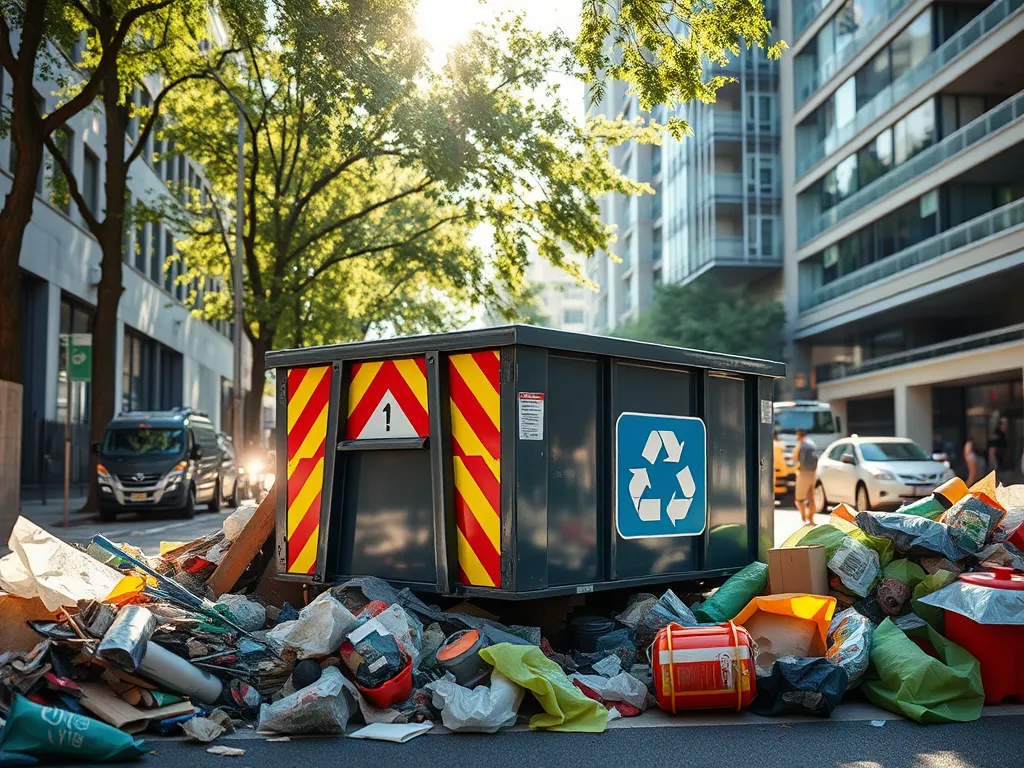The Ultimate Guide to Front-Load Dumpsters: Benefits & Uses

Understanding Front-Load Dumpsters: An Essential Guide
Front-load dumpsters are highly efficient waste management solutions commonly used by businesses and commercial establishments. These dumpsters feature a unique design that allows for convenient loading and unloading, making them ideal for environments where space is limited. With their front-facing doors that swing open, they provide easy access for waste disposal, ensuring that businesses can manage their refuse effectively while maintaining cleanliness and order.
Front-load dumpsters come in various sizes to accommodate different volumes of waste. Typically ranging from 2 to 8 cubic yards, these dumpsters cater to the needs of restaurants, retail stores, and construction sites, among other industries. The front-loading mechanism allows waste to be deposited easily from the front, making it more user-friendly compared to traditional rear-load dumpsters. This feature has made front-load dumpsters a popular choice for organizations aiming to optimize their waste disposal processes.
Effective community initiatives can significantly enhance our efforts in Waste Reduction & Recycling while promoting environmental sustainability.
The versatility of front-load dumpsters extends beyond size options. Many waste management companies offer customizable solutions, allowing businesses to select dumpster styles based on their specific requirements. From color schemes to branding options, businesses can personalize their front-load dumpsters to align with their corporate identities. This level of customization not only enhances brand visibility but also encourages responsible waste disposal practices among employees and customers alike.
When considering waste management options, organizations often compare front-load and rear-load dumpsters. Front-load dumpsters provide distinct advantages, particularly in terms of ease of use and efficiency. Rear-load dumpsters, while suitable for certain settings, require more space and effort to access. Front-load dumpsters, on the other hand, can be placed closer to the premises, thus optimizing space while facilitating faster waste disposal. This comparison highlights the importance of choosing the right dumpster type based on specific business needs.
In summary, front-load dumpsters offer valuable solutions for waste management. Their designs provide space efficiency, user-friendliness, and flexible sizes, making them an excellent choice for various commercial applications. By employing front-load dumpsters, businesses can streamline their waste disposal operations while promoting sustainable practices.
Types of Front-Load Dumpsters
Standard front-load dumpster sizes typically range from 2 to 8 cubic yards. These options allow businesses to select a size that best fits their waste generation needs. Smaller dumpsters, such as the 2 or 4 cubic yard models, are often used by local cafes or small retail stores, whereas larger models, like the 6 or 8 cubic yards, are better suited for larger establishments such as supermarkets and hotels. This variety ensures that there’s a suitable option for any business's specific waste management requirements.
Many dumpster service providers offer customizable options to meet unique business needs. Customizable features can include adjustable pickup schedules, additional capacity options, and specialized containers for recycling or hazardous materials. Businesses can coordinate with waste management companies to tailor their front-load dumpster services according to operational requirements, ensuring a solution that fits seamlessly within their waste disposal workflow.
When comparing front-load dumpsters with rear-load dumpsters, several differences arise. Front-load dumpsters are generally easier to access and require less space for use. They have a front-loading design, which allows collection vehicles to easily lift and empty them without needing extensive operational space behind the unit. Conversely, rear-load dumpsters require more maneuvering due to their design, making them less convenient in tight spaces, especially in urban environments where space is a premium.
Benefits of Front-Load Dumpsters
Front-load dumpsters provide significant space-saving advantages, especially in congested business environments. Their compact design allows them to fit into tighter areas, maximizing the usable space for businesses. By minimizing the footprint required for waste management, businesses can keep their premises orderly and enhance the overall appearance of their property, which can be crucial for customer-facing operations.
Ease of access is another notable benefit of front-load dumpsters. With their front-opening doors, employees can quickly and easily dispose of waste materials without the need to maneuver around the dumpster. This increased accessibility can lead to improved sanitation practices among staff and foster a culture of responsible waste disposal in the workplace.
From a financial perspective, front-load dumpsters are often more cost-effective for commercial businesses. Their efficient design allows for quicker pickups and less frequent emptying compared to larger capacity rear-load dumpsters. Over time, this can lead to lower overall waste management costs for businesses, making front-load dumpsters a viable option for managing waste economically.
Additionally, front-load dumpsters can have a positive environmental impact. Many businesses that utilize these dumpsters can adopt a zero-waste approach or enhanced recycling practices. With customized options for segregating different types of waste, front-load dumpsters support sustainability goals and help businesses reduce their overall waste footprint, contributing to a greener environment.
How to Choose a Front-Load Dumpster
Choosing the right front-load dumpster begins with assessing the waste volume needs of the business. Understanding how much waste is generated on a weekly or monthly basis helps determine the appropriate size and frequency of pickups. Businesses should evaluate their operations, taking into account peak times for waste generation, to select a dumpster that adequately meets their needs without overcommitting on space or costs.
After assessing waste volume, businesses should select the right size and type of front-load dumpster based on their requirements. It's essential to consider the specific materials being disposed of, as different dumpsters may be designed to handle various types of waste. Consulting with waste management providers can lead to informed choices and ensure that your selected dumpster suits your business's operational workflows.
Understanding local regulations and restrictions regarding waste disposal is crucial when selecting a front-load dumpster. Different municipalities may have specific guidelines on the types of materials that can be disposed of and the sizes of dumpsters permitted in certain areas. Compliance with these regulations is essential for avoiding potential fines and ensuring responsible waste disposal, making it prudent for businesses to research these regulations beforehand.
Maintenance of Front-Load Dumpsters
Cleaning and sanitizing front-load dumpsters regularly is imperative to maintain hygiene, especially in high-traffic commercial locations. Businesses can create a cleaning schedule to ensure that dumpsters are washed and disinfected periodically. Doing so helps eliminate odor and pests while extending the operational life of the dumpster, ensuring a more pleasant waste management experience.
Routine inspections and regular repairs are crucial for maintaining the integrity of front-load dumpsters. Companies should check for any signs of wear and tear, such as rust or damage to the doors that could hinder proper functioning. Addressing these issues proactively prevents larger problems in the future and ensures that the dumpster remains compliant with health and safety standards.
Implementing proper loading techniques is vital in minimizing potential issues with front-load dumpsters. Overloading or improperly packing waste can lead to jams or damage to the dumpster. Staff training on safe loading methods can help avoid complications and encourage a culture of responsible dumping, resulting in fewer service interruptions and minimized risks.
Front-Load Dumpsters for Businesses
For businesses, adopting best practices for waste management translates into effective operational efficiency. Utilizing front-load dumpsters allows for organized waste disposal, minimizing clutter and maximizing the utility of the workspace. By implementing structured waste management practices, businesses can better track their waste generation and make more sustainable choices regarding waste reduction.
Contracting with reputable dumpster service providers is essential for ensuring a reliable waste management solution. Businesses should conduct thorough research and consider factors such as customer service, responsiveness, and pricing. Engaging with a company that aligns with your waste management philosophy can help streamline the overall process and foster a long-term working relationship.
Many industries have set examples of effective waste management practices utilizing front-load dumpsters. For instance, restaurants benefit from regular capacity assessments leading to optimal dumpster sizing, while retail stores can enhance customer experiences by maintaining clean and organized premises. Sharing these successful waste management strategies can provide valuable insights for businesses looking to maximize their operational efficiency.
Challenges of Using Front-Load Dumpsters
Despite their many benefits, front-load dumpsters are not without challenges. Some common issues include accessibility during pick-up times and maintaining adequate separation between different types of waste. Organizations can address these concerns through proper scheduling, staff training, and adhering to best practices in waste management to enhance overall performance.
Space constraints in urban areas can pose significant challenges for the effective use of front-load dumpsters. Businesses located in crowded locations may find it difficult to secure enough space for the dumpster and allow the waste collection truck to perform its service efficiently. In such cases, working with waste management providers to identify strategic dumpster placements is essential to mitigate space limitations.
Safety concerns during the usage of front-load dumpsters are always a priority for businesses. Training staff on proper handling and disposal techniques can help minimize accidents and ensure compliance with safety regulations. Regular safety audits and adherence to workplace safety standards are critical components of a comprehensive waste management strategy that incorporates front-load dumpsters.
